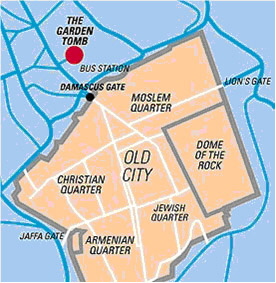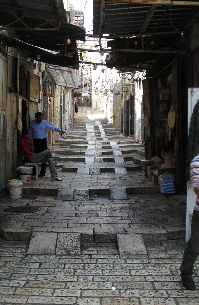|
Who would have thought that such a tiny country would have so much to offer? During a recent week
-long visit to Israel, I found there was more than enough to attract visitors, not just from a religious
perspective, but also for enjoying archaeological sites and participating in outdoor adventures.
Most flights arrive very early in the morning, a good opportunity to take advantage of the day (and get
over jetlag) by starting your touring immediately. I was met at Ben Gurion Airport by my private guide –
and I most definitely recommend that everyone be accompanied by a guide. Not only will the guide take
care of the driving, their knowledge of the local history and culture easily supplements your guidebook and brochures.
We drove one hour from the airport towards Jerusalem. Here is the city of the Bible, very clearly divided
into the Old Jerusalem (Old City) and the New Jerusalem. We first drove to Mount of Olives, which offers
a very clear overview over the entire area. Ignore the hordes of visitors and the camel available for photographs. The Old City sits behind giant walls as it did two thousand years ago.
 You may notice the original gates are angled so that you can't enter directly into the city without making a sharp 90-degree angle turn. This was to
prevent enemies on horseback from charging full-speed, straight ahead through them, and to make it difficult to use a long battering ram to break them down. On Zion Gate, outside the
Armenian and Jewish quarters, you can see a hole through which boiling liquids could be poured on attackers. You may notice the original gates are angled so that you can't enter directly into the city without making a sharp 90-degree angle turn. This was to
prevent enemies on horseback from charging full-speed, straight ahead through them, and to make it difficult to use a long battering ram to break them down. On Zion Gate, outside the
Armenian and Jewish quarters, you can see a hole through which boiling liquids could be poured on attackers.
Right below Mount of Olives sits the Garden of Gethsemane (Gethsemane
means "oil press" in Hebrew) where it is said Jesus prayed the night before his death. Here, several olive trees are said to be nearly 1,000 years old. Overlooking the garden is the Church
of all Nations, built on the ruins of several other churches destroyed over the centuries.
With only one day to see Jerusalem, we concentrated our visit to the Old City, located on a hill behind the
walls. The hill is believed to have been inhabited since the 4th millennium BC. Its southern section was
walled in around 1850 BC by Canaanites who established a settlement there. It was this city that King David captured in around 1000 BC and renamed the City of David.
David intended to build a sanctuary to God as the first temple of the Israelites in Jerusalem outside the
city walls on the northern edge of the hill. He purchased the area known as Mount Moriah from the owner,
and the temple was eventually completed by David's son, Solomon. The temple was destroyed by
Nebuchadnezzar II of Babylon in 586 BC. Subsequent wars, church reconstructions and destructions have taken place for hundreds of years in this tiny spit of land.
Once we parked, we started walking. Good walking shoes, and bottled water, are a must! We entered the
walled city and stopped first at the Western Wall, a significant prayer site for Jewish Orthodox. Here, the
plaza in front of the wall is separated by a portable divider to split the prayer area into the men's and
women's zones. The construction of the wall is impressive; above ground is an exposed section of the
ancient fortification built during the Herodian period on the western flank of the Temple Mount. More sections of the original wall can be seen underground.
 The Old City is divided into quarters – the Jewish Quarter, Muslim Quarter, Christian Quarter and the Armenian Quarter.
Here, a city within a city functions much as it has for centuries. Narrow streets bypass numerous Arab shops. The Jewish Quarter was largely destroyed in 1948 during the Arab
-Israeli war, and much of it has been restored. This is where the history of King David and his son, Solomon, come to life, as you walk through a restored section of the original "cardo"
or road. Most of the restored sites lie beneath the Old City streets, as throughout the centuries other rulers built atop the ruins of the conquered city. Walking up and down narrow
stairways and tunnels is a necessity to capture the essence of this site. The Old City is divided into quarters – the Jewish Quarter, Muslim Quarter, Christian Quarter and the Armenian Quarter.
Here, a city within a city functions much as it has for centuries. Narrow streets bypass numerous Arab shops. The Jewish Quarter was largely destroyed in 1948 during the Arab
-Israeli war, and much of it has been restored. This is where the history of King David and his son, Solomon, come to life, as you walk through a restored section of the original "cardo"
or road. Most of the restored sites lie beneath the Old City streets, as throughout the centuries other rulers built atop the ruins of the conquered city. Walking up and down narrow
stairways and tunnels is a necessity to capture the essence of this site.
The Muslim Quarter is the largest, and most of the Christian
sites are located within it, including the Via Dolorosa. The Christian Quarter is home to the Church of the Holy Selpulchre, reputed to be the site of the Calvary where Jesus was
crucified and also the location of the cave in which he was buried. To see the Calvary site, you must walk up a very steep set of stairs to face a lavishly decorated
altar and the Rock of Calvary, under glass on both sides of the altar. Beneath the altar there is a hole said to be the place where the cross was raised.
Various areas of the church are maintained by a number of religious sects, to the point where agreement
must be reached by all of them before any renovations are completed. On the second level above the
entrance to the church, a ladder has remained in the same location for over 100 years as a result of a
disagreement about moving it. It's also interesting to note that one of the most significant sites to
Christians is opened and closed daily by two Muslim families, a tradition that has existed for several hundred years.
 The centerpiece of the Old City is the Temple Mount, currently
inaccessible to anyone except Muslims. The site is the location of the al-Aqsa Mosque and the Dome of the Rock, the oldest Islamic structure in
the world. While walking through the Old City it is not unusual to hear the Muslim call to prayer on loudspeakers throughout the day, although I did not see any Muslims stop their work to pray. The centerpiece of the Old City is the Temple Mount, currently
inaccessible to anyone except Muslims. The site is the location of the al-Aqsa Mosque and the Dome of the Rock, the oldest Islamic structure in
the world. While walking through the Old City it is not unusual to hear the Muslim call to prayer on loudspeakers throughout the day, although I did not see any Muslims stop their work to pray.
After leaving the Old City we drove to the location of King David's Tomb,
but I would recommend future visitors by-pass this site. The authenticity of the site has been challenged on several grounds and there's little to see
except for a sarcophagus covered with a blue cloth. The room where the sarcophagus lies is also divided into two, one half for the women and the
other for the men. In the same building is also the Upper Room where the Last Supper is said to take place. Once again, not much to see and highly
contested as the actual site. We would have much rather seen Caiapha's House, but we did not have time.
Recommendations: Women and men can wear shorts that are knee
-length to enter most holy sites, but women must have shoulders covered. If in doubt, bring a shawl. During the summer months, the heat can be
tremendous and dehydration a good possibility. Drink lots of water, even if you are not thirsty. Very comfortable walking shoes (two pairs) are highly recommended.
See the Photo Gallery for this article here.
Read the article on Galilee here
|